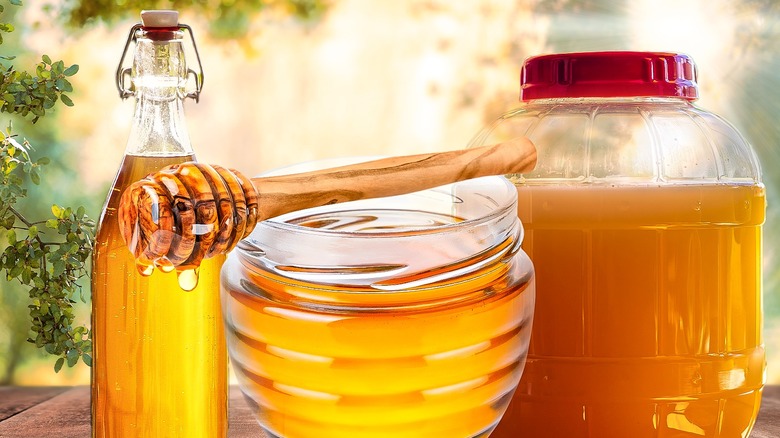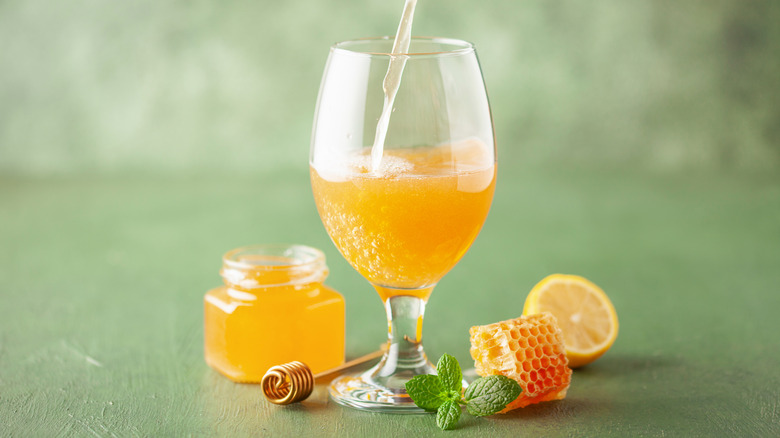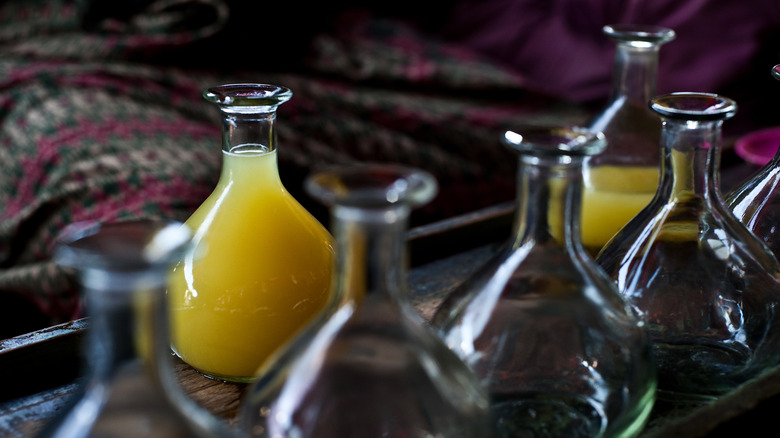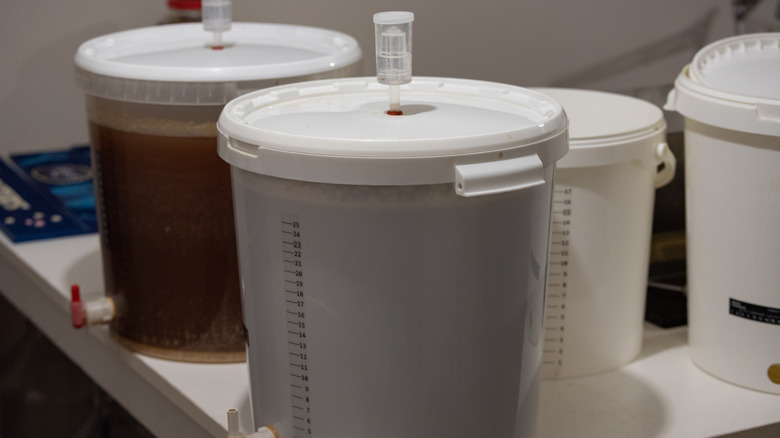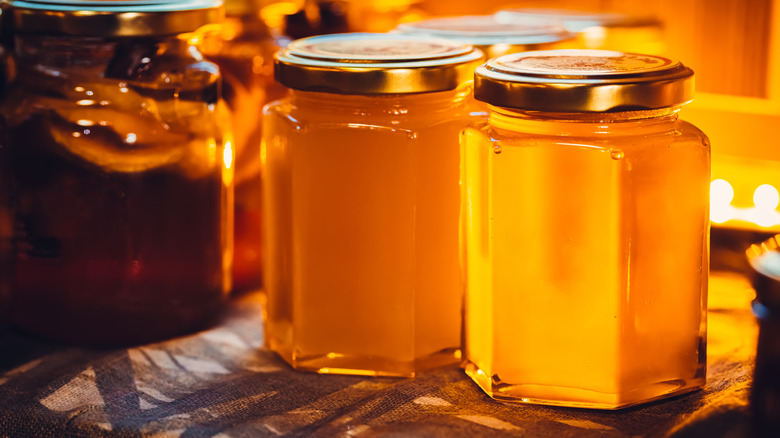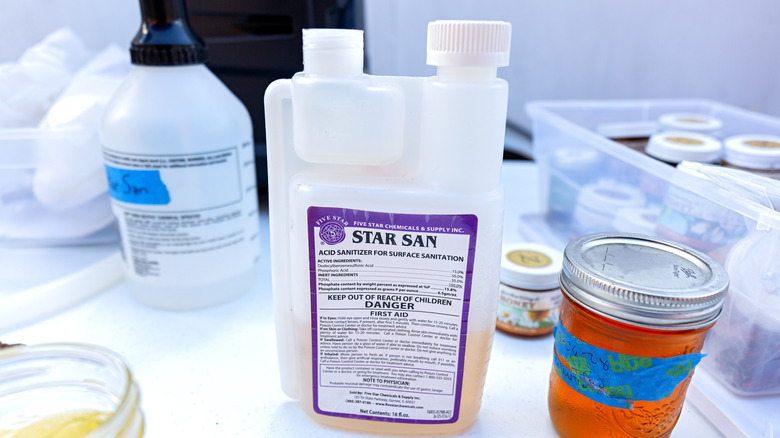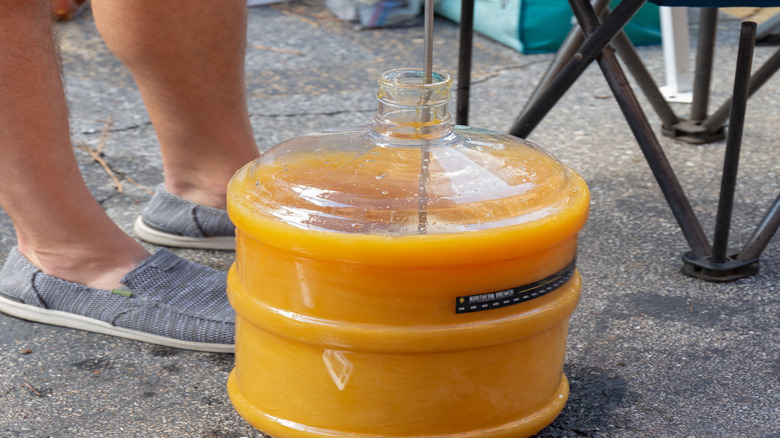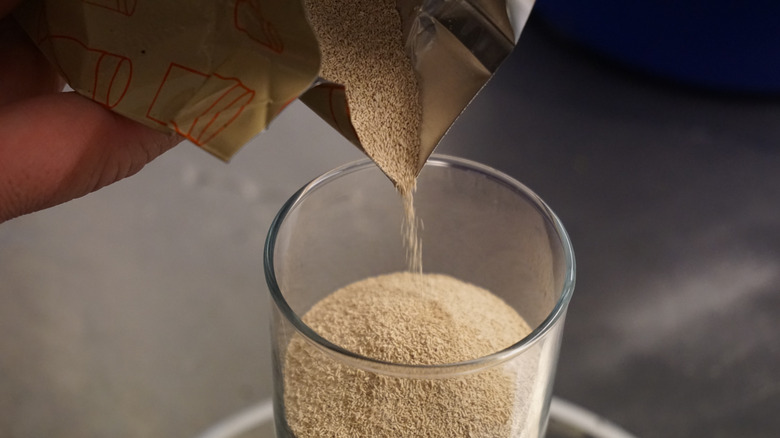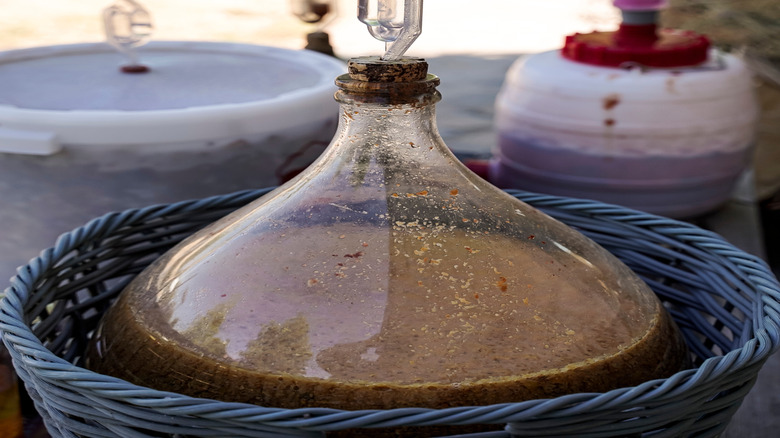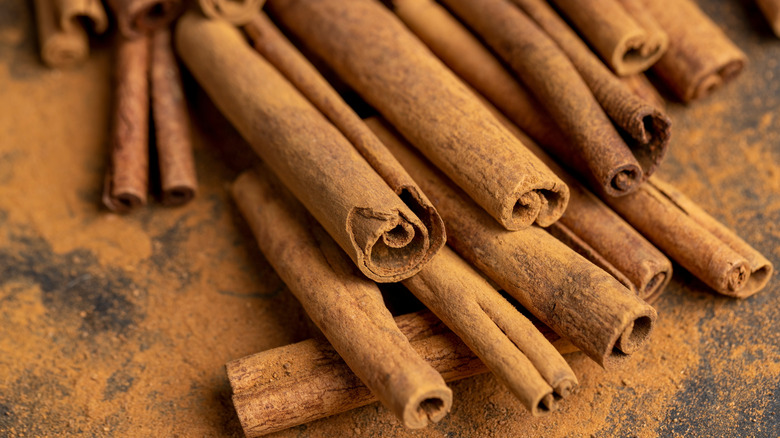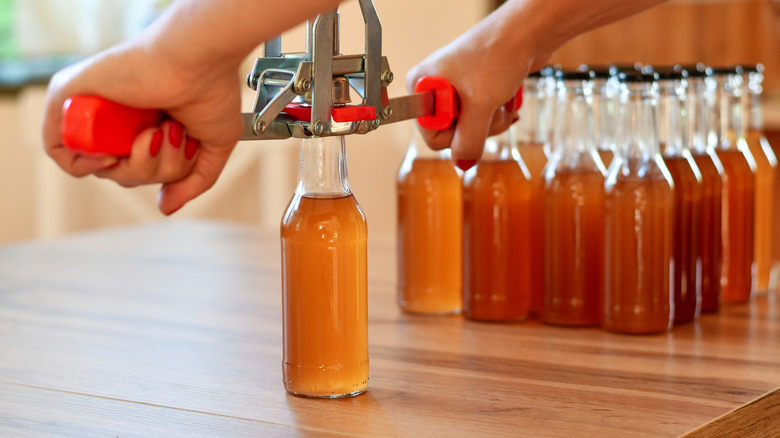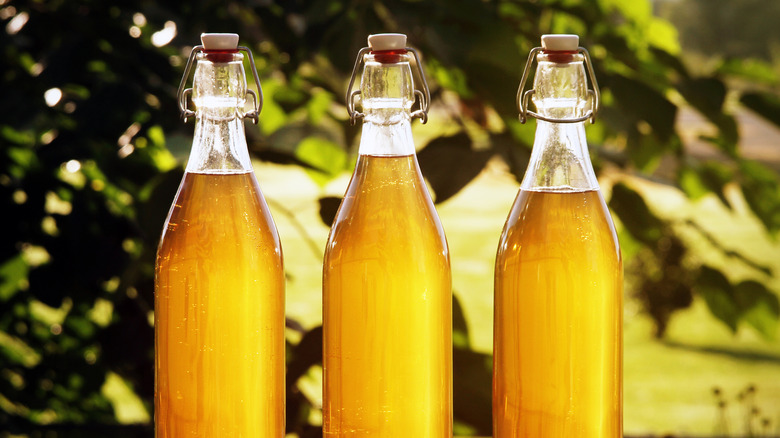How To Make Mead From Honey
We may receive a commission on purchases made from links.
You may not have noticed, but mead is having a moment. The fermented honey drink, once a niche product rarely seen Stateside outside of medieval fair food tents and historical re-enactments, is slowly growing in popularity among mainstream social drinkers looking to mix up their beer and hard seltzer routines. Meaderies large and small have emerged across the country in recent years, and experts predict the U.S. mead market will expand to $281.57 million by 2032.
If you're curious to try mead but don't have a meadery or a well-stocked bottle shop near you, you can still satisfy your curiosity: Do as medieval cosplayers and homebrewing hobbyists have done for decades and make it yourself. The process isn't as complicated as you might imagine. Basic mead contains just honey, water, and yeast, which are mixed together and allowed to ferment. To show you the ropes, we've enlisted help from a team of certified mead-tasting judges — Richard Furlong, Matt Nielson, and Dan Short — who are also award-winning mead makers.
What is mead?
An alcoholic beverage made from honey, mead is not quite the same as wine, though the two share some similarities. If you're picturing a syrupy sweet drink that tastes like watered-down honey, though, you're in for a pleasant surprise — the world of mead is a lot more diverse than most people realize. Even if you're not a fan of sweet drinks, you can still enjoy dry meads. If you enjoy the bubbles of beer and seltzer, you can also find sparkling meads. Love hard cider? Try cizer, mead flavored with cider or apple juice. And fans of fruity drinks can enjoy melomel, or mead flavored with fruits such as berries or citrus. Finally, those who love cocktails with spiced or herbal notes may enjoy metheglin, a mead flavored with herbs and spices.
Most of us know of mead's ancient history because of its association with medieval Europe. But in fact, its roots go far deeper. The earliest meads appeared in Africa and are thought to date back 20,000 to 40,000 years. The ancient Greeks so revered mead, they considered it the drink of the gods, with all the magical and curative powers that suggests. Elsewhere, cultures around the world, from the Incas and Aztecs of the Americas to Scandinavian countries and Egypt, all developed their own varieties of mead. So if you're a fan of mead, you're part of a bigger club than you might realize.
Before you make mead
While making a basic mead requires relatively little hands-on work, it still needs care and time. Like all alcoholic drinks, it needs to ferment and age, and this could take several weeks, with the exact time depending on the type of mead you're making and the yeast you're using. If you want to make homemade mead for a special event, plan your production schedule accordingly — like all home brewing projects, mead-making is an exercise in delayed gratification.
And while you might imagine the process of making an ancient brew such as mead to be rough and rustic, getting the mead you want requires attention to detail. Every step, from cleaning your equipment to mixing in your honey, must be done with care to ensure you don't end up with any off flavors. So be prepared to have fun — but pay attention to each step of the process.
What you'll need to make mead
Mead doesn't need expensive equipment. The earliest meads were simply honey dissolved in water and fermented by airborne wild yeast, the same way natural wines are produced today. For beginners, a bare-bones approach can work well for mead, with easy-to-find household equipment. "You will need a fermenting vessel, some form of an air lock, and cleaning chemicals," Dan Short says. While home brewing shops offer a range of specialized equipment for home fermentation, Short advises that you can get by with a clean gallon pickle jar and use a balloon as an airlock — this serves to release the carbon dioxide generated by fermentation while keeping outside air and airborne contaminants out of the fermenter.
Matt Nielson recommends an alternate setup, saying, "For a novice, I would recommend a two-gallon food grade bucket as a main fermenter (since a bucket allows for easy access), and a one-gallon glass jug as a second, or aging, vessel (apple juice or cider jugs are my favorite source for this)." In addition, Nielson advises that you'll need an airlock and a length of tubing to siphon the mead from the fermenter to the aging vessel. If you're more serious about brewing mead, though, Nielson recommends some advanced gear. "Some additional, recommended equipment would be a hydrometer or refractometer (for measuring the progress of fermentation), a medium to large scale (for measuring out honey into the fermenter), and a small jeweler's scale with 0.1 gram resolution (for measuring out nutrients and stabilizers)."
Gather your ingredients
The most important ingredient in mead is honey, and you'll need a lot of it. "To make a wine strength (12-14% ABV) traditional mead, approximately 3 pounds of honey will be needed per gallon of liquid. One gallon of honey (about 12 pounds) would be needed for a 5-gallon batch of mead," Matt Nielson said. And your choice of honey matters. "My favorite thing about mead is the wide variety of honey available: Wildlflower honey is probably the truest expression of terroir," Nielson said. For beginners, Dan Short recommends orange blossom honey. "It is the most forgiving, I think, in terms of a sweetness to retained flavor, because as you ferment it out, you're going to lose a lot of flavors," he said.
You will also need yeast, and for this, you'll need to look for varieties specifically formulated for brewing — the packet in your pantry for baking won't do. And to ensure a predictable fermentation, Nielson also recommends yeast nutrients. "One thing to remember is that honey itself is very low in nitrogen, a requirement for yeast health and growth," he explained. "It is highly recommended to use a supplemental yeast nutrient (such as Fermaid O), as this will vastly increase the quality of your mead."
Sanitize your equipment
Before you start making your mead, you must sanitize everything your mead ingredients touch — measuring cups and spoons, funnels, stirring implements, and your fermenting vessel and airlock. While your gear doesn't need to be clean-room sterile, it needs a more thorough cleanse than the standard trip through the dish sink. "Not keeping stuff sterile, that's the biggest mistake," Dan Short says. Don't take any shortcuts with the process, either — dust or bacteria on a stirring implement or in a fermenter can doom your mead before you've even started to make it. As Short explains, "75% of any brewing is cleaning."
"All the equipment should be cleaned with either dish soap, an enzymatic and fragrance-free detergent," advises Nielson, who recommends a product like Seventh Generation dish soap or a specialist cleaning agent like Powdered Brewery Wash (PBW). You'll need to make sure any visible dirt is removed before the final sanitization step. "A food grade, no-rinse sanitizer such as StarSan is highly recommended," he says. "These only need a short contact time and do not require any rinsing." Nielson said. If you use StarSan, don't worry about the residual foam that may remain in your fermenting vessel after you sanitize it — it's perfectly safe and won't affect the flavor or fermentation of your mead.
Combine your honey with water
Many people envision homebrewing as a complex process involving lots of boiling and mixing, and it can be if you're making some types of beer. But mead — especially if you start with a basic, beginner-friendly recipe — is surprisingly straightforward to make. All you have to do is mix your honey with water until it's dissolved, then add your yeast and yeast nutrient, then wait. You don't even need to heat up the water. "Heating or sterilizing the water first is not necessary, explains Matt Nielson. Being naturally antiseptic is why concentrated honey never expires, and all the other equipment should have already been sanitized. While regular tap water will work, Richard Furlong noted, "I would suggest using bottled water from the store."
But if you've ever fought to stir a stubborn gob of honey into a cocktail in place of simple syrup, you'll know that getting honey to dissolve can take some elbow grease. This is especially true if you're working with several pounds of the sticky stuff along with a gallon or more of water. Nielson likes to incorporate half of the water into the honey before topping it off with the remaining water. While you can use a long-handled spoon or balloon whisk to stir the honey and water together, Nielson speeds up the process by using a lees stirrer, like this Stainless Steel Mix-Stir, attached to a cordless drill. As he says, "Work smart, not hard."
Add the right yeast for the mead you want
Yeast is the secret ingredient that turns honey-sweetened water into mead. And to get great mead, it's crucial to choose the right yeast and give it a healthy environment so it can do its job properly and give you the flavor profile you want. Fortunately, as Dan Short explains, "There are a lot of commercial examples of mead-specific yeasts now.". He added that possible yeasts range from traditional wine yeasts, which will produce drier meads, to special mead yeasts that stop fermenting sooner, leaving behind more residual sugar and giving sweeter finished meads.
"Some of the best options for new mead makers are wine yeasts that have low nutrient requirements and wide fermentation temperature ranges," Matt Nielson said. "Lalvin QA23 and K1V-1116 are two great choices." To keep yeast healthy, Richard Furlong injects oxygen into the mead before adding the yeast. "I would suggest to add pure oxygen with an oxygen wand you can get from the brew shop to oxygenate your mead," he says. "It is impossible to get the proper amount of O₂ into your mead by just shaking, using the pure O₂ will help prevent stuck fermentation. You just need about 30 seconds of O₂ for a 5-gallon batch." And as Nielson noted earlier, adding a yeast nutrient can help ensure that your yeast will thrive.
Find a safe place for your mead to ferment
Once you've added yeast to your mead, it's time to let it ferment. Because the mead will bubble and expand as the yeast releases gas, you should ensure your fermenting vessel is big enough to hold everything without leaking. "One potential issue during fermentation is that a vigorous fermentation can overflow your container (especially if adding in a nutrient addition). This is easily mitigated by using a larger vessel," Matt Nielson says. "The best container for fermenting mead is one that allows for easy access, and is about 1.25-2 times larger than the batch you are making. For a 1-gallon batch, a 2-gallon bucket is great; for a 5-gallon batch, a 6.5-gallon bucket allows for plenty of room."
Once your mead is in the fermenter, your next step is to set it aside in a space with a fairly stable temperature. "Don't make it and keep it in your kitchen," Dan Short warns. "It's going to have temperature fluctuations and it's going to be too hot. Sometimes too cold." These fluctuations, he explained, can stress yeast. You don't have to overthink possible storage areas, though. "I always tell people, pick the closet you go into the least and put it in the back," Short mentions. Fermentation, Richard Furlong explains, takes three to five weeks. "You will also have a yeast sediment at the bottom of your carboy. That is when you want to rack your mead to the smaller carboy," he says, noting that this will prevent oxidation by reducing the headspace. This shorter, secondary aging period, Furlong explains, is to separate the mead from the yeast and allow it to settle and clarify.
Add flavorings, if desired
One of the things mead makers — and drinkers — love about mead is the endless variety of flavors it can have, depending on what the maker decides to add. Creative mead makers have concocted versions flavored with everything from berries to chilis to spices and chocolate (or even take inspiration from Mexican hot chocolate and use a combination of these). While it's probably wise for novices to keep their first batch simple, it's never a bad idea to learn about your other options.
You can add flavoring agents either during the first fermentation period or during aging, after the mead has been taken off the yeast and moved into a smaller container. "In general, ingredients added during the fermentation period will likely have their flavors transformed by the yeast, and ingredients added after fermentation is over/during aging will be truer to character," Matt Nielson explains. "For fruits, add them during aging for a fresh fruit character and during primary fermentation for a more integrated, wine-like character. Spices should be added during aging." Richard Furlong recommends adding delicately flavored fruit such as mangos and peaches during the aging stage. To flavor your mead with spices, he says to "boil your spices to make a strong tea and add by taste."
Bottle the finished mead
Once your mead has settled (and been flavored), it's time to bottle it for storage and serving. "Bottles of various sizes are a standard packaging option for mead," Matt Nielson says. "Standard 12-ounce beer bottles and caps are an easily accessible and affordable option, as are swing top bottles with rubber/silicone seals. Wine bottles (either 375 or 750 ml) are an attractive option."
To easily transfer your mead from its aging vessel to the bottles, you'll need a racking cane (a siphon that lets you control the flow of liquid into your bottles) and food-grade plastic tubing to channel the mead from the aging container — these can sometimes be bought together, like with this Fermtech Stainless Steel Auto-Siphon. You may also need metal caps, with a capper to clamp them to the bottles, or alternately, corks and a corker if you're using wine bottles. No matter how you plan to bottle your mead, keep everything that touches the beverage fastidiously clean. "Once again, sanitize everything," stresses Richard Furlong, "bottles, caps, bottling bucket, and bottling cane."
Store and enjoy
Once you've bottled your mead, it's ready to share and enjoy. You're not going to drink it all at once, so to ensure every bottle is as good as the last, you'll want to store it safely. "Wine bottles with natural corks should be stored on their side; all others should be stored upright," Matt Nielson advises; storing wine bottles on their sides keeps their corks from drying out, keeping them airtight, allowing unopened wines to last for a long time. Sealed bottles don't need to be refrigerated, but they should stay in an area with a stable temperature. "Store mead inside, not in the garage with wild temperature swings," Richard Furlong advises.
So how should you serve the mead you've worked so hard to make? The short answer is any way you like. "To borrow from one of my favorite distilling people, the best way to enjoy it is whatever you think tastes best," Dan Short says. "Okay, if it's chilled because you like it chilled, do it that way. If it's room temp because you like it room temp, do it that way. If it's supposed to be bubbly and you hate the bubbles, I know plenty of people that are like, 'I don't do bubbly drinks' and let it go flat and drink it that way."
How long does mead last?
If you make a one-gallon batch of mead, chances are you'll finish it all or give it all away before it has a chance to go bad. But if you plan to store some away for a special occasion, you should know what to expect as it ages. "Mead lasts about 3 years in bottles," says Richard Furlong, noting that using a preservative like food grade Potassium Sorbate will help it to last. "After 3 years, oxidation will start to occur, and the sorbate can chemically change and give off a celery flavor."
How you seal your bottles can also impact their longevity. Dan Short notes that if you're keeping your mead in beer bottles, you might start to notice some off-flavors after about a year. Corked bottles, he adds, can last longer, depending on the type of cork you use — some are rated for longer storage periods, such as corks intended for aged red wines, while others are intended for wines meant to be drunk young. The alcohol content of mead also plays a role in its shelf life. "As with any alcoholic beverage, a higher ABV can yield a higher aging potential," Matt Nielson says. "An 18% ABV mead packaged in wine bottles with high quality corks can last decades."
